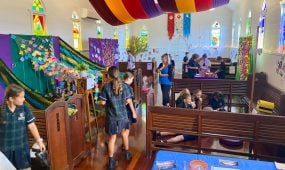Nurturing student-centred engagement with scripture
Features
“Many experienced educators desire an opportunity or device that encourages both authentic academic engagement and student-centred and directed interaction with complex scriptural writings, as either a catalyst or means of nurturing their journey of discovery. To this end, we have combined three known processes into a single lesson,” says Churchie Religious Education Faculty Head, Max Condon

Twenty-first-century learners bring new challenges and various social contexts to their Religious Education classrooms. These challenges consist of the ‘visible’ and ‘invisible’ constraints of our schooling system. The ‘visible’ being timetable, time allocation, teacher availability, specialist teacher theological education or the lack of it, classroom space and the time of day.
Approaches to these visible challenges need to be considered with respect to the ‘unseen’, which include diverse student spiritual or religious experiences; student prior knowledge, literacy levels, degree of interest and perceived need; parental support; and, teacher expectations and educational objectives.
Related Story
 Features
Features
The art of finding God in all things
To cater to this increasingly complex and ever-changing educational climate, secondary school Religious Education programs tend to range from either a ‘one-size-fits-all’ program (which is high in content and able to be assessed using traditional teacher-directed formative or summative instruments) or a social pastoral care program in a youth group format (with a ‘how we are feeling today’ approach, focusing on group interactions without any formalised learning objectives, assessment or extending experiential methodology).
Many experienced educators desire an opportunity or device that encourages both authentic academic engagement and student-centred and directed interaction with complex scriptural writings, as either a catalyst or means of nurturing their journey of discovery. To this end, we have combined three known processes into a single lesson as a tool to teach deeper interaction using biblical texts and writings as the literature to be engaged with.
Consisting of three specific processes in a four-stage method, the secondary student is able to engage with the set biblical texts, resulting more deeply in student-centred and generated outcomes. The three processes we have blended into one are:
- Lectio Divina (or ‘divine reading’) – a joint spiritual mediation exercise.
- LAC (‘Literacy Across the Classroom’) – taught by librarian educators (a local school initiative across all curriculum areas).
- Cornell Notes – with a faculty academic studies focus, as an across-faculty skill instrument (as explained in this Cornell Note Taking post)
Each of these processes has four distinct components that seamlessly overlap and are taught as part of the whole without diminishing the strengths of the different techniques.
This process occurs once a cycle in Years 7-9 with the literature determined by the Religious Education faculty, taught by literature experts and expanded upon within the Religious Education classes with student-directed outcomes.
Passages we have used to date with Year 8 Churchie students include:
- Matthew 6.9-13, The Lord’s Prayer
- John 1.1-5, In the beginning…
- Matthew 5.1-12, The Beatitudes
- Romans 8.28-37, And we know in all things
Here is a sample lesson using this method, which may be downloaded for readers to use.





